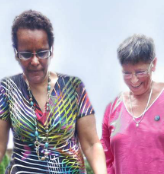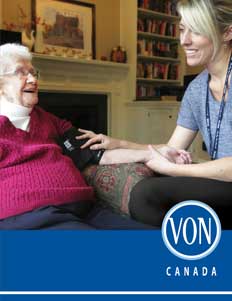From newborns to palliative care, rejuvenated non-profit takes the lead in community healthcare
The Victorian Order of Nurses (VON) has a long and remarkable history, proudly serving the evolution of health and wellness in Canada since 1897. After two World Wars, the Great Depression, and decades of declining funding and growing needs, this vital, not-for-profit organization looks forward to the future with expanded, innovative services and a broad focus on education and prevention.
Given the country’s aging population and the preference of Canadians to “age at home”, VON Canada has developed a vision for home and community care, titled Health Starts at Home. The vision reflects a rich and intimate knowledge of the sector, and the health and social needs of Canadians of all ages from coast to coast. Following publication of the corporation’s Annual Report for 2013-14, Jo-Anne Poirier, President and CEO of VON Canada, speaks candidly about recent changes, challenges, and the VON’s optimistic outlook for the next five years.
“We view it as a journey,” Poirier explains. “Looking to refresh the brand, and talk about our unique value proposition at VON. We are the largest not-for-profit in Canada that provides a lot of wraparound services in both home care and community support. The governments in different provinces are realizing that we have tremendous value in helping people stay at home.”
Meeting Regional Challenges
This “full basket of home care” includes not only clinical services, but also congregate services that reduce social isolation and help clients stay healthy through preventative means. Education of the public is key for a company viewed solely as a home care organization in the past. Today, VON has a much broader mandate which has evolved due to a real need in different regions. The expanded profile includes community support services such as transportation, nutrition, assisted living, adult day and respite care, and private pay for those who may not qualify for government programs.
 “It’s about appealing to all of the demographic root,” says Poirier. “There may be a perception that we only cater to seniors, but really, we provide a range of services for the whole community – from newborns to palliative care.”
“It’s about appealing to all of the demographic root,” says Poirier. “There may be a perception that we only cater to seniors, but really, we provide a range of services for the whole community – from newborns to palliative care.”
The beauty of the VON model is the “grass roots” style that takes regional differences into account when tailoring operations to suit the needs of the community, in concert with funders. Poirier notes, “Often, provincial governments have different funding models. We adapt to those, while working closely with the government to make sure we fulfill our obligations to see as many clients as we can and offer the greatest care.”
Dealing with rules that vary by province is a challenge, but one that benefits the big picture. “It certainly adds a complexity,” Poirier admits, “but also a richness. If we have developed a good practice (like our SMILE program in Ontario), we will approach other provincial governments to let them know we have an innovation in another region that might be transported into their own community. That seems to be resonating well.”
S.M.I.L.E
S.M.I.L.E. – Seniors Maintaining Independent Living Easily – is about the government “giving us a pot of money” for a particular individual. It may be for clinical services, but it could also be for cutting wood, clearing snow, help with bathing, cooking meals, etc. Provincial governments are realizing it takes more than clinical services to help people stay at home and healthy. Nova Scotia, for example, is trying to defer the time when an individual has to go into a long-term care facility. The cost differences are considerable:
Home Care $46 / day
Long-term Care Facility $125 / day
Hospital $450 – $1000 / day
Poirier is candid about the options. “Given the choice, people really do want to age and, frankly, die at home, surrounded by their loved ones. This is obvious in the bequests we receive from people who recognize the great services VON has offered them or a family member.”
S.M.I.L.E is only one of many innovative programs underway. VON also has an e-Nursing program that allows a practitioner to go into the home and then be coached electronically by a nurse. “And we are rolling out hand-held devices to assist nurses and PSWs (Personal Support Workers). This kind of technology moves us closer to the day when patients will be able to monitor their own health with the help of a professional. Electronic medical records is another development we look forward to.”
Full Steam Ahead
The vision for the next five years sees VON Canada becoming even more efficient, with advances in technology playing a huge role. Program development to help caregivers is another priority – targeting family members who look after their loved ones, and need a break themselves.
“It’s really about prevention,” says Poirier. “More preventative programs to help people stay healthy. A great example is our adult day program for people with dementia. There is one gentleman in his 80s who drops off his wife for the day. She gets social interaction, a nice hot meal, and exercises. He gets to go downhill skiing! So, he has the much-needed break and then they are both happy to see each other.”
Looking ahead, Jo-Anne Poirier states her own positive vision for the future of VON Canada: “Continuing to take that business rigor to an organization that has a wonderful social mission – that’s my plan.”
Victorian Order of Nurses: VON Canada
Past
- Lady Ishbel Aberdeen, wife of the Governor General of Canada, founded an order of visiting nurses in Canada, to address the hardships and illness affecting women and children in isolated areas of the young country.
February 10, 1897, Prime Minister Sir Wilfrid Laurier offered a motion inaugurating the Victorian Order of Nurses for Canada… “as a mode of commemoration by the Dominion (Canada) of Queen Victoria’s diamond jubilee.”
Present
52 VON sites across Canada in 10 provinces
Largest sites in Hamilton, London, Toronto, Halifax, Moncton
14,000 total work force
5,000 paid staff; 9,000 unpaid volunteers
AT A GLANCE
WHO: VON Canada (Victorian Order of Nurses)
WHAT: Canada’s largest national, not-for-profit, charitable home and community care organization
WHERE: 52 sites in 10 provinces across Canada
WEBSITE: www.von.ca


